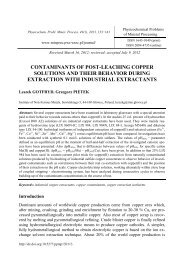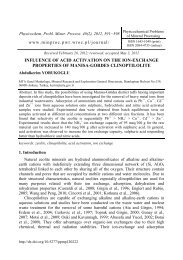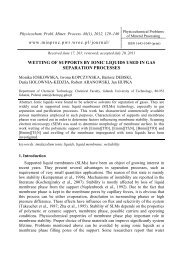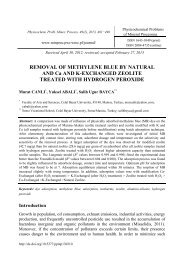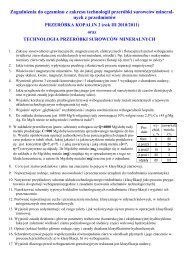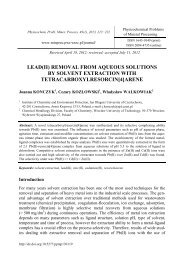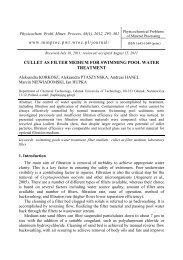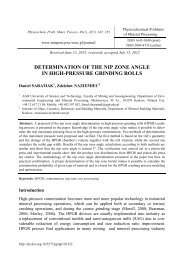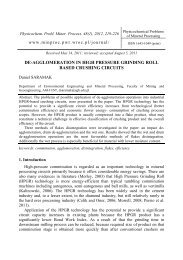Expanded perlite aggregate characterization for use as a lightweight ...
Expanded perlite aggregate characterization for use as a lightweight ...
Expanded perlite aggregate characterization for use as a lightweight ...
You also want an ePaper? Increase the reach of your titles
YUMPU automatically turns print PDFs into web optimized ePapers that Google loves.
Physicochem. Probl. Miner. Process. 49(2), 2013, 689−700<br />
www.minproc.pwr.wroc.pl/journal/<br />
Physicochemical Problems<br />
of Mineral Processing<br />
ISSN 1643-1049 (print)<br />
ISSN 2084-4735 (online)<br />
Received: July 1, 2012; reviewed, accepted: February 27, 2013<br />
EXPANDED PERLITE AGGREGATE<br />
CHARACTERIZATION FOR USE AS A LIGHTWEIGHT<br />
CONSTRUCTION RAW MATERIAL<br />
Atila Gurhan CELIK * , Ahmet Mahmut KILIC ** , Gaye Ozgur CAKAL ***<br />
*<br />
National Boron Research Institute, Dumlupınar Bulvari, No: 166-10, 06520 Ankara, Turkey, agce_1@hotmail.com<br />
**<br />
Mining Engineering Department, Cukurova University, 01330 Adana, Turkey<br />
***<br />
Ankara University, Institute of Nuclear Sciences, 06100 Tandoğan, Ankara, Turkey<br />
Abstract: The purpose of this study is to investigate the <strong>use</strong> of İzmir (Menderes-Cumaov<strong>as</strong>ı) expanded<br />
<strong>perlite</strong> <strong>as</strong> a construction raw material by determining its characteristic properties, <strong>as</strong> well <strong>as</strong> its physical<br />
properties at different temperatures (up to 600°C). The <strong>perlite</strong>s, having gl<strong>as</strong>sy, porous structure, were<br />
found to contain 70.68% SiO 2 and 13.04% Al 2 O 3 . The physical properties of the <strong>perlite</strong>s changed with<br />
temperature. The highest surface area, 524 m 2 /g, w<strong>as</strong> obtained at 400°C. The physical properties were<br />
found to have high statistical relation. It w<strong>as</strong> concluded that expanded <strong>perlite</strong> <strong>aggregate</strong>s could be <strong>use</strong>d <strong>as</strong><br />
a construction raw material.<br />
Keywords: <strong>perlite</strong>, <strong>lightweight</strong> <strong>aggregate</strong>, characteristic property, physical property, temperature,<br />
construction raw material<br />
Introduction<br />
Perlite, which is obtained from pumice, contains 2–5% water and h<strong>as</strong> a gl<strong>as</strong>sy <strong>for</strong>m of<br />
rhyolitic or dacitic magma. The commercial product, commonly designated <strong>as</strong><br />
expanded <strong>perlite</strong>, is produced by heating the material to 760–1100 °C, thereby<br />
converting its indigenous water to vapor and causing the material to expand to 4 to 20<br />
times its original volume while <strong>for</strong>ming <strong>lightweight</strong> high-porosity <strong>aggregate</strong>s (Dogan<br />
and Alkan, 2004; Harben and Bates, 1990). The heating process does not change the<br />
<strong>perlite</strong> density (2.2–2.3 kg/dm 3 ) but the bulk density decre<strong>as</strong>es to 60–80 g/dm 3 . During<br />
the thermal treatments, a structural transition from amorphous to crystalline occurs,<br />
accompanied by incre<strong>as</strong>ed cation exchange capacity (CEC) from 20–30 to 35–50<br />
cmol/kg, <strong>as</strong> a result of the multiplication of broken edges, and incre<strong>as</strong>ed specific<br />
surface area from 1.2 to 2.3 m 2 /g (Dogan and Alkan, 2004).<br />
http://dx.doi.org/10.5277/ppmp130227
690 A.G. Celik, A.M. Kilic, G.O. Cakal<br />
Perlite is b<strong>as</strong>ically the mineral obsidian. Perlite mineral deposits exist in many<br />
countries of the world, but the expanded product is only available in countries which<br />
have commercial expanding plants (Topcu and Isıkdag, 2007). The world reserves of<br />
<strong>perlite</strong> are estimated <strong>as</strong> 700 million tons. In 2011, 1.7 million tons had been produced,<br />
mostly by Greece (500.000 Mg), United States (375.000 t) and Turkey (220.000 Mg);<br />
however, no in<strong>for</strong>mation <strong>for</strong> China, leading producer, w<strong>as</strong> available (Bolen, 2011).<br />
Turkey’s 160.000 tons of probable <strong>perlite</strong> reserves are located in Menderes, İzmir.<br />
Although our country h<strong>as</strong> rich resources and capacity of <strong>perlite</strong>, domestic demand is<br />
very limited and most of the produced <strong>perlite</strong> is imported.<br />
Perlite is <strong>use</strong>d in various are<strong>as</strong> such <strong>as</strong> construction materials, agriculture, medical<br />
and chemical industry. Moreover, expanded <strong>perlite</strong> <strong>aggregate</strong> (EPA) h<strong>as</strong> been <strong>use</strong>d<br />
within the constructional elements such <strong>as</strong> brick, pl<strong>as</strong>ter, pipe, wall and floor block;<br />
however h<strong>as</strong> not been industrially utilized in concrete yet. EPA is a heat and sound<br />
insulator, and <strong>lightweight</strong> material which ensures economic benefits in constructions<br />
(Topcu and Isıkdag, 2008). Many researchers have studied the characteristic properties<br />
of the <strong>perlite</strong>s and their <strong>use</strong> <strong>as</strong> construction materials (Singh and Garg, 1991;<br />
Demirboga et al., 2001; Demirboga and Gul, 2003; Lanzon and Garcia-Ruiz, 2008;<br />
Sari et al., 2009; Sengul et al., 2011; Çelik, 2010). In these studies, mainly the <strong>use</strong> of<br />
<strong>perlite</strong> <strong>as</strong> a thermal insulator in <strong>lightweight</strong> concrete and brick production w<strong>as</strong><br />
examined.<br />
The aim of this study is to determine the characteristic properties of Menderes<br />
expanded <strong>perlite</strong> <strong>aggregate</strong> and investigate changes in their physical properties<br />
depending on temperature. Also, the analyses, to determine the <strong>use</strong> of EPA <strong>as</strong> a raw<br />
material <strong>for</strong> construction, are per<strong>for</strong>med. This study will be the b<strong>as</strong>is of the<br />
<strong>for</strong>thcoming studies in which Menderes expanded <strong>perlite</strong> <strong>aggregate</strong> is <strong>use</strong>d <strong>as</strong> a<br />
construction raw material.<br />
Materials and method<br />
<strong>Expanded</strong> <strong>perlite</strong> w<strong>as</strong> obtained from Menderes-Cumaov<strong>as</strong>ı Perlite Processing Plant of<br />
Eti Mine Works (İzmir, Turkey). Perlites were expanded to 0.2-2 mm size and 150-<br />
300 kg/m 3 density at 1000 C by using high-temperature furnaces at Eti Mine<br />
Menderes Works.<br />
To determine the characteristic properties of the expanded <strong>perlite</strong> at ambient<br />
temperature, chemical analysis, petrographic analysis, qualitative mineralogical<br />
analysis (XRD); scanning electron microscopy (SEM) analysis, energy dispersive X-<br />
ray spectroscopy (EDS) analysis, thermo-gravimetric/differential thermal (TG-DTA)<br />
analysis, and surface area me<strong>as</strong>urements were per<strong>for</strong>med. At the same time, to find out<br />
some of the important physical properties of the expanded <strong>perlite</strong>s at ambient<br />
temperature and temperatures up to 600 C, specific gravity, bulk density, porosity,<br />
water absorption and compactness ratio analyses were carried out on five different<br />
samples. The sieve analysis, fine matter analysis, organic matter content and loss on
<strong>Expanded</strong> <strong>perlite</strong> <strong>aggregate</strong> <strong>characterization</strong> <strong>for</strong> <strong>use</strong> <strong>as</strong> a <strong>lightweight</strong> construction raw material 691<br />
ignition analyses were also per<strong>for</strong>med to determine the <strong>use</strong> of expanded <strong>perlite</strong> <strong>as</strong> a<br />
construction raw material. Analyses were per<strong>for</strong>med at Mining Technical Research<br />
Institute (MTA), Ankara, Turkey and Middle E<strong>as</strong>t Technical University (METU)<br />
Chemical Engineering Department, Ankara, Turkey.<br />
Petrographic analysis w<strong>as</strong> done by Olympus BH-2 microscope. Chemical analysis<br />
of the 105 C dried samples w<strong>as</strong> per<strong>for</strong>med by using the Siemens SRS 300 X-ray<br />
Fluorescence Spectrometer (XRF) instrument. XRD of the powdered samples w<strong>as</strong><br />
carried by using Rigaku XRD Geigerflex equipped with Cu X-ray tube. XRD patterns<br />
were recorded from 20°
692 A.G. Celik, A.M. Kilic, G.O. Cakal<br />
Results and discussion<br />
Mineralogical and petrographic analyses of EPA<br />
Perlite, in terms of color and chemical composition, resembles mostly to pumice. The<br />
most effective way of separating <strong>perlite</strong> from diatomite, pumice and other volcanic<br />
originated rocks is their mineralogical and petrographic analyses. The chemical<br />
analysis results are given in Table 1. As a result of the chemical analysis, it w<strong>as</strong><br />
observed that <strong>perlite</strong> h<strong>as</strong> an average SiO 2 and Al 2 O 3 amount of 70.68% and 13.04%,<br />
respectively, which is compatible with the literature (Topcu and Isıkdag, 2007; Tekin<br />
et al., 2010). Also <strong>as</strong> a result of the XRD analysis (Figure 1), <strong>perlite</strong> samples were<br />
found to consist of amorphous silica and opal-CT (98%) and trace amounts of feldspar<br />
and quartz. A similar XRD pattern w<strong>as</strong> also found by Sodeyama et al. (1999).<br />
Table 1. Chemical analysis and loss on ignition analysis results of EPA samples (%)<br />
Sample No SiO 2 Al 2 O 3 Na 2 O K 2 O Fe 2 O 3 CaO+MgO *LoI<br />
1 70.7 13.0 3.6 4.6 0.8 3.9 3.1<br />
2 69.8 12.1 3.3 4.2 1.1 3.5 3.0<br />
3 71.4 13.8 3.8 3.9 1.6 3.6 3.2<br />
4 70.4 13.4 3.5 4.4 1.0 3.9 3.1<br />
5 71.1 12.9 3.5 4.6 0.7 4.0 3.0<br />
Average 70.68 13.04 3.54 4.34 1.04 3.78 3.08<br />
*LoI: Loss on ignition<br />
Fig. 1. XRD analysis of EPA
<strong>Expanded</strong> <strong>perlite</strong> <strong>aggregate</strong> <strong>characterization</strong> <strong>for</strong> <strong>use</strong> <strong>as</strong> a <strong>lightweight</strong> construction raw material 693<br />
The petrographic investigation on the expanded <strong>perlite</strong> is given in Figure 2. As seen<br />
from the microphotograph, <strong>perlite</strong> had a gl<strong>as</strong>sy and porous structure. There w<strong>as</strong><br />
countless number of pores, each having different micron sizes. This structure of the<br />
<strong>perlite</strong> makes it lighter, while providing a big advantage in terms of heat and sound<br />
transmission. In the analysis, the presence of opal-CT, feldspar, mica, illite and quartz<br />
minerals were determined within the <strong>perlite</strong> structure (Figure 2).<br />
Fig. 2. Microphotograph showing feldspar and quartz in EPA<br />
Fig. 3. SEM images of EPA<br />
SEM images of EPA, Figure 3, also had a crystal-like porous and gl<strong>as</strong>sy structure.<br />
SEM images are similar to the image given by Sarı et al. (2009). The proportional<br />
distribution of the elements, determined by EDS analysis (Figure 4), showed that<br />
within the expanded <strong>perlite</strong> samples, silicon (45.13%), oxygen (38.91%), aluminum<br />
(8%), pot<strong>as</strong>sium (5.58%) and sodium (2.37%) were present.
694 A.G. Celik, A.M. Kilic, G.O. Cakal<br />
Fig. 4. EDS analysis of EPA<br />
Thermal analyses of EPA<br />
From the TGA analysis (Figure 5), it w<strong>as</strong> found that the <strong>perlite</strong> sample lost all its<br />
moisture till 200C and had a weight loss of 1.4% at 450 C. At temperatures above<br />
500°C, no considerable weight loss (0.3%) w<strong>as</strong> observed. At 1000 C, <strong>perlite</strong> had a<br />
total weight loss of 1.8%, which shows that it can be <strong>use</strong>d at high-temperature<br />
applications. Roulia et al., 2006 also found that expanded <strong>perlite</strong> retains 1.6–1.9 wt%<br />
water <strong>for</strong> all studied temperatures (till 950°C). The dehydration in <strong>perlite</strong>s is divided to<br />
three temperature ranges by Roulia et al., 2006: 0–250°C, 250–550°C and 550–950°C.<br />
In the first temperature range, the molecular water bound loosely either superficially<br />
or adsorbed in pores are rele<strong>as</strong>ed. In the second temperature range molecular water<br />
trapped into the inner pores of the material is rele<strong>as</strong>ed. At the l<strong>as</strong>t temperature range –<br />
OH groups <strong>as</strong>sociated to the oxygen atoms through strong hydrogen bonding are<br />
rele<strong>as</strong>ed.<br />
Besides, DTA curve gave an exothermic peak at 250 C. This broad peak<br />
corresponds to the rele<strong>as</strong>e of water either bound loosely or trapped into the inner pores<br />
of expanded <strong>perlite</strong>. The exothermic peak can also be attributed to the gl<strong>as</strong>s<br />
compression and internal surface area diminution. Roulia et al. (2006) also found an<br />
exothermic peak in the DTA curve <strong>for</strong> expanded <strong>perlite</strong> at around 250°C. The ph<strong>as</strong>e<br />
change started in the temperature range of 500-600 °C and completed at 1000 C.
<strong>Expanded</strong> <strong>perlite</strong> <strong>aggregate</strong> <strong>characterization</strong> <strong>for</strong> <strong>use</strong> <strong>as</strong> a <strong>lightweight</strong> construction raw material 695<br />
Fig. 5. TG-DTA curves of EPA (heating rate = 20 C/min.)<br />
To determine the m<strong>as</strong>s loss of expanded <strong>perlite</strong> with heat, loss on ignition test w<strong>as</strong><br />
per<strong>for</strong>med and the results are given in Table 1. As seen in Table 1, the loss on ignition<br />
of EPA w<strong>as</strong> less than 5% (3.08±0.09%). This result confirms that EPA can be <strong>use</strong>d <strong>as</strong><br />
a construction raw material when tested according to TS 1114 EN 13055-1 standard.<br />
Variation of physical properties of EPA with temperature<br />
Surface area, bulk density, specific gravity, porosity, water absorption and<br />
compactness ratio values of EPA were determined at different temperatures and given<br />
in Table 2. The highest surface area (523.8±18.5 m 2 /g) w<strong>as</strong> obtained at 400 °C which<br />
decre<strong>as</strong>ed with the incre<strong>as</strong>e in temperature. As temperature w<strong>as</strong> incre<strong>as</strong>ed above<br />
400°C, thermolysis began and the <strong>perlite</strong> samples started to decompose. At<br />
temperatures above 600 °C, the decomposition of <strong>perlite</strong> samples w<strong>as</strong> practically<br />
Temperature<br />
( o C)<br />
Table 2. Physical properties of EPA at different temperatures<br />
Surface<br />
area<br />
(m 2 g -1 )<br />
Specific<br />
gravity<br />
(kg/m 3 )<br />
Bulk<br />
density<br />
(kg/m 3 )<br />
Porosity (%)<br />
Water<br />
absorption<br />
(%)<br />
Compactness<br />
ratio<br />
Ambient 108.77.1 197390 23010 791.30 71.11.0 0.120.04<br />
100 295.44.3 195850 22020 681.90 67.80.9 0.110.07<br />
200 308.511.2 193695 21020 562.00 63.70.9 0.110.03<br />
300 442.916.7 192260 19010 481.10 59.80.7 0.100.01<br />
400 523.818.5 190580 15040 431.10 51.50.8 0.080.04<br />
500 265.58.9 188640 10010 360.95 48.50.6 0.060.01<br />
600 73.06.4 184560 8510 300.85 44.50.6 0.050.01
696 A.G. Celik, A.M. Kilic, G.O. Cakal<br />
finished and the surface area decre<strong>as</strong>ed. Bulk density, specific gravity, porosity and<br />
compactness ratio values decre<strong>as</strong>ed depending on the temperature. The highest values<br />
were reached at 100 °C, where<strong>as</strong> the lowest values were attained at 600 °C. EPA h<strong>as</strong><br />
a specific gravity of 1973±90 kg/m 3 and bulk density of 230±10 kg/m 3 at 100°C,<br />
where<strong>as</strong> these values decre<strong>as</strong>ed to 1905±80 kg/m 3 and 150±40 kg/m 3 at 400°C,<br />
respectively. The porosity, water absorption and compactness ratio of EPA decre<strong>as</strong>ed<br />
from 79.00±1.30% to 43.00±1.10%, 71.1±1.0% to 51.5±0.8%, and 0.12±0.04% to<br />
0.08±0.04% at 400°C, respectively.<br />
Sieve, fine matter and organic content analyses<br />
Sieve analysis, fine matter analysis and organic matter content analyses were<br />
per<strong>for</strong>med to investigate if EPA could be <strong>use</strong>d <strong>as</strong> a construction raw material. From<br />
the sieve analysis (Figure 6), per<strong>for</strong>med according to TS 1114 EN 13055-1 standards,<br />
it w<strong>as</strong> observed that EPA w<strong>as</strong> within the standard range. So it can be concluded that it<br />
can be <strong>use</strong>d during the production of construction materials.<br />
Fig. 6. Sieve analysis curve<br />
Fine matter analysis of EPA, given in Table 3, w<strong>as</strong> per<strong>for</strong>med to determine the<br />
suitability of 0-4 mm particle size to TS 1114 EN 13055-1 standard. The fine matter<br />
analysis defined in the standard w<strong>as</strong> the percent ratio of the oversized material to the<br />
undersized residue when 0.063 mm sieve opening w<strong>as</strong> <strong>use</strong>d. The evaluation of the<br />
results showed that fine matter content w<strong>as</strong> less than 5% (3.68±0.07%) <strong>as</strong> specified in<br />
the standard. Presence of organic matter in EPA is inconvenient and unfavorable.<br />
According to the experimental criteria given in TS EN 1744-1 standard, no organic<br />
matter <strong>for</strong>mation w<strong>as</strong> detected in EPA. These analyses together with m<strong>as</strong>s loss on<br />
ignition analysis showed that EPA can be <strong>use</strong>d <strong>as</strong> a construction raw material.
<strong>Expanded</strong> <strong>perlite</strong> <strong>aggregate</strong> <strong>characterization</strong> <strong>for</strong> <strong>use</strong> <strong>as</strong> a <strong>lightweight</strong> construction raw material 697<br />
Table 3. Fine matter amounts of EPA (0-4 mm sieve opening)<br />
Sample No 1 2 3 4 5<br />
Dry weight (g) 1030 1050 1100 1050 1000<br />
0.063 mm – Oversize weight (g) 480 456 502 483 448<br />
1.0+0.5 mm – Oversize weight (g) 212 198 225 211 204<br />
1.6+1 mm – Oversize weight (g) 146 165 174 150 142<br />
2+1.6 mm – Oversize weight (g) 106 119 111 124 109<br />
4+2 mm – Oversize weight (g) 44 73 52 49 56<br />
Total oversize material weight (g) 988 1011 1064 1017 958<br />
Total undersize residue weight (g) 42 39 36 33 42<br />
Fine matter ratio (%) 4.07 3.71 3.27 3.14 4.20<br />
Average (%) 3.68<br />
Comparison of characteristic properties<br />
When the characteristic properties of <strong>perlite</strong> were examined, it w<strong>as</strong> observed that<br />
chemical analysis, petrographic analysis, XRD, SEM and EDS analysis results support<br />
each other. TG-DTA analysis showed changes in direct proportion to the m<strong>as</strong>s loss on<br />
ignition. Besides, significant statistical relations exist between the physical properties<br />
of the <strong>perlite</strong>; especially between specific gravity and bulk density (R 2 = 0,9252) (Fig.<br />
7), bulk density and porosity (R 2 = 0,9246) (Figure 8), water absorption and specific<br />
gravity (R 2 = 0,9501) (Figure 9), compactness ratio and specific gravity (R 2 = 0,9297)<br />
(Fig. 10). It can also be seen that although there exists sets of relationships between<br />
the physical properties of the expanded <strong>perlite</strong>, they also decre<strong>as</strong>e with temperature.<br />
300<br />
Bulk Density (kg/m 3 )<br />
270<br />
240<br />
210<br />
180<br />
150<br />
120<br />
90<br />
60<br />
30<br />
y = 1,2888x - 2302,5<br />
R² = 0,9252<br />
0<br />
1800 1825 1850 1875 1900 1925 1950 1975 2000 2025<br />
Specific Gravity (kg/m 3 )<br />
Fig. 7. Relationship between specific gravity and bulk density
698 A.G. Celik, A.M. Kilic, G.O. Cakal<br />
90<br />
80<br />
70<br />
y = 0,3844x - 685,78<br />
R² = 0,9246<br />
Porosity (%)<br />
60<br />
50<br />
40<br />
30<br />
20<br />
10<br />
0<br />
1800 1825 1850 1875 1900 1925 1950 1975 2000 2025<br />
Specific Gravity (kg/m 3 )<br />
Fig. 8. Relationship between specific gravity and porosity<br />
80<br />
70<br />
y = 0,2266x - 376,49<br />
R² = 0,9501<br />
Water Absorption (%)<br />
60<br />
50<br />
40<br />
30<br />
20<br />
10<br />
0<br />
1800 1825 1850 1875 1900 1925 1950 1975 2000 2025<br />
Specific Gravity (kg/m 3 )<br />
Fig. 9. Relationship between specific gravity and water absorption<br />
0,2<br />
0,18<br />
Compactness Ratio<br />
0,16<br />
0,14<br />
0,12<br />
0,1<br />
0,08<br />
0,06<br />
0,04<br />
0,02<br />
y = 0,0006x - 1,0361<br />
R² = 0,9297<br />
0<br />
1800 1825 1850 1875 1900 1925 1950 1975 2000 2025<br />
Specific Gravity (kg/m 3 )<br />
Fig. 10. Relationship between specific gravity and compactness ratio
<strong>Expanded</strong> <strong>perlite</strong> <strong>aggregate</strong> <strong>characterization</strong> <strong>for</strong> <strong>use</strong> <strong>as</strong> a <strong>lightweight</strong> construction raw material 699<br />
Conclusions<br />
During the studies aiming to investigate characteristic properties of EPA and find its<br />
suitability <strong>as</strong> construction raw material, many of its properties were determined. The<br />
chemical composition of the expanded <strong>perlite</strong> w<strong>as</strong> found to consist of 70.68% SiO 2<br />
and 13.04% Al 2 O 3 . The petrographic observations showed presence of opal-CT,<br />
feldspar, mica, illite, and quartz in the <strong>perlite</strong> structure. SEM images showed a crystal<br />
like porous and gl<strong>as</strong>sy structure. EDS analysis showed the presence of 45.13% silicon<br />
and 38.91% oxygen within the EPA structure. A weight loss of 1.8% at 1000 °C w<strong>as</strong><br />
found from the TG-DTA analysis meaning that expanded <strong>perlite</strong> can be utilized at<br />
high temperature applications. Although specific gravity, bulk density, porosity, water<br />
absorption and compactness ratios differ at different temperatures, they were found to<br />
have high statistical relation. In addition, surface area w<strong>as</strong> also affected by<br />
temperature. To determine whether EPA could be <strong>use</strong>d <strong>as</strong> a construction raw material<br />
or not, sieve analysis, fine-matter content and m<strong>as</strong>s loss on ignition analysis and<br />
organic matter content were per<strong>for</strong>med and it w<strong>as</strong> found that EPA w<strong>as</strong> appropriate to<br />
be <strong>use</strong>d <strong>as</strong> a <strong>lightweight</strong> construction raw material.<br />
Acknowledgements<br />
This work is supported by National Boron Research Institute (BOREN) via project number BOREN-<br />
2008-B0201. We are grateful to Eti Mine Menderes Works <strong>for</strong> the supply of expanded <strong>perlite</strong>, Mining<br />
Technical Research Institute (MTA) and Chemical Engineering Department of Middle E<strong>as</strong>t Technical<br />
University <strong>for</strong> the analyses.<br />
References<br />
ASTM-C 127-42 Standard Test Method <strong>for</strong> Specific Gravity and Absorption of Coarse Aggregates.<br />
ASTM C 128-57 Standard Test Method <strong>for</strong> Specific Gravity and Absorption of Fine Aggregates.<br />
BOLEN P. W., 2011. USGS Mineral Commodity Summaries 2011. U.S. Department of the Interior, U.S.<br />
Geological Survey, Reston, Virginia-USA.<br />
CELIK A.G., 2010. Production of <strong>lightweight</strong> bricks from boron added <strong>perlite</strong> mixtures and<br />
determination of technological properties. Ph.D. Dissertation, Çukurova University, Department of<br />
Mining Engineering, Adana.<br />
DEMIRBOGA R., ORUN I., GUL R., 2001. Effects of <strong>Expanded</strong> Perlite Aggregate and Mineral<br />
Admixtures On The Compressive Strength of Low-Density Concretes. Cement Concrete Res. 31(11),<br />
1627–1632.<br />
DEMIRBOGA R., GUL R., 2003. The Effects of <strong>Expanded</strong> Perlite Aggregate, Silica Fume and Fly Ash<br />
on The Thermal Conductivity of Lightweight Concrete. Cement Concrete Res. 33 (5), 723-727.<br />
DOGAN M., ALKAN M., 2004. Some Physicochemical Properties of Perlite As An Adsorbent. Fresenius<br />
Environmental Bulletin. 13, 252–257.<br />
HARBEN P. W., BATES R.L., 1990. Industrial Minerals Geology and World Deposits. Metal Bulletin<br />
Inc., London.
700 A.G. Celik, A.M. Kilic, G.O. Cakal<br />
LANZON M., GARCIA-RUIZ P.A., 2008. Lightweight Cement Mortars: Advantages and<br />
Inconveniences of <strong>Expanded</strong> Perlite and Its Influence on Fresh and Hardened State and Durability.<br />
Construction and Building Materials. 22, 1798-1806.<br />
ROULIA M., CHASSAPIS K., KAPOUTSIS J.A., KAMITSOS E.I., SAVVIDIS T., 2006. Influence of<br />
Thermal Treatment on the Water Rele<strong>as</strong>e and the Gl<strong>as</strong>sy Structure of Perlite. J Mater Sci. 41, 5870-<br />
5881.<br />
SARI A., KARAIPEKLI A., ALKAN C., 2009. Preparation, Characterization and Thermal Properties of<br />
Lauric Acid/<strong>Expanded</strong> Perlite As Novel Form-Stable Composite Ph<strong>as</strong>e Change Material. Chemical<br />
Engineering Journal. 155, 899–904.<br />
SENGUL O., AZIZI S., KARAOSMANOGLU F., TASDEMIR M., 2011. Effect of <strong>Expanded</strong> Perlite on<br />
The Mechanical Properties and Thermal Conductivity of Lightweight Concrete. Energy and<br />
Buildings. 43, 671–676.<br />
SINGH M., GARG M., 1991. Perlite-B<strong>as</strong>ed Building Materials A Review of Current Applications.<br />
Construction and Building Materials. 5(2), 75-81.<br />
SODEYAMA K., SAKKA Y., KAMINO Y., SEKI H., 1999. Preparation of Fine <strong>Expanded</strong> Perlite.<br />
Journal of Materials Science. 34, 2461-2468.<br />
TEKIN N., DINCER A., DEMIRBAS O., ALKAN M., 2010. Adsorption of Cationic Polyacrylamide (C-<br />
PAM) on <strong>Expanded</strong> Perlite. Applied Clay Science. 50, 125-129.<br />
TOPCU I.B., ISIKDAG B., 2007. Manufacture of High Heat Conductivity Resistant Clay Bricks<br />
Containing Perlite. Building and Environment. 42, 3540–3546.<br />
TOPCU I.B., ISIKDAG B., 2008. Effect of <strong>Expanded</strong> Perlite Aggregate on The Properties of Lightweight<br />
Concrete. Journal of materials processing technology. 204, 34–38.<br />
TS 1114 EN 13055-1, 2004. Lightweight Aggregates - Part 1: For Use In Concrete, Mortar And The<br />
Juice.<br />
TS 3529, 1980. Determination of Specific Gravity and Water Absorption Ratio in Concrete Aggregates.<br />
TS EN 1744-1, 2000. Tests <strong>for</strong> Chemical Properties of Aggregates-Part 1: Chemical Analysis.



